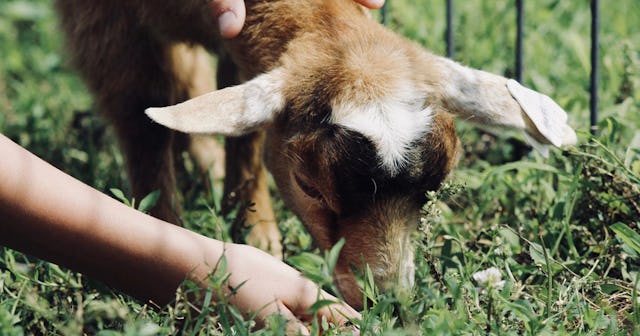Turns Out Petting Zoos Are Full Of SuperBugs

The last time I took my children to a petting zoo was at the state fair. There were the sweetest baby lambs there. Just adorable, and my middle daughter, Norah, was all about it. She must have been seven at the time. She sat one of those little suckers on her lap and just hugged it. Then she kissed its forehead, and cried a little when we had to leave.
Thinking back, I’m like 90% sure we washed our hands after leaving the petting zoo. Maybe 95%. But now, after reading about a new study put out by the European Congress of Clinical Microbiology & Infectious Diseases in Amsterdam, I’m going to be 150% sure. In fact, I might just avoid petting zoos all together.
According to the report, “[A]nimals in petting zoos can result in shedding and transmission of MDR (multidrug-resistant) pathogens that may cause illness for human visitors, even when the animals appear healthy…”
You might want to read that again, just to make sure it sank in.
Now if you are like me, I paused a moment on MDR because it’s a term I’ve heard, but never fully understood. According to the Mayo Clinic, multidrug drug resistant bacteria, commonly known as superbugs, are strains of bacteria that are resistant to the majority of antibiotics commonly used today. Resistant bacteria that cause pneumonia, urinary tract infections and skin infections are just a few of the dangers.
According to the study, researchers in Israel collected 382 samples of poop, skin, fur and feathers from more than 200 animals that lived in eight petting zoos in the country. They tested the samples for bacteria resistant to multiple classes of antibiotics. And what did they find?
Well … it’s not awesome. Not awesome at all. About 12% of the animals sampled had at least one multidrug-resistant strain of bacteria living on them, and a quarter of those animals had more than one. Animals that were treated with antibiotics were seven times more likely to pass the multidrug-resistant bacteria on to other animals.
This is only one study, but the Centers for Disease Control and Prevention reports that between 2010 to 2015, there were more than 100 outbreaks of illness that began at petting zoos, fairs and educational farms. While 100 cases in a five-year span isn’t huge, when I take my kids to the petting zoo, or really anywhere for that matter, I have a zero percent tolerance for superbugs. I know that seems high, but I have high standards when it comes to my children. No shame.
Patryk Sobczak/Unsplash
And some of these cases were actually pretty deadly. USA Today published an article on superbugs in petting zoos recently where they highlighted a number of newsworthy stories where children contracted serious illnesses after visiting petting zoos.
In 2016, an Indiana mom shared that her 2-year-old son died after visiting a petting zoo at the Indiana State Fair and contracting E. coli, although the exact source of the infection was not determined. A 20-month-old in Maine died of E. coli complications after visiting a county fair petting zoo. The family of a North Carolina 2-year-old sued a petting zoo in 2013 after he died from an E. coli infection.
The CDC actually has a number of very helpful tips when it comes to visiting petting zoos. And I must say, some of them aren’t all that shocking, but there were a couple that I hadn’t even considered. The rest are a good reminder.
Not shocking: Children 5 and younger, people with weakened immune systems, and those 65 and older are most vulnerable to the germs animals carry. They also recommend that if you own a petting zoo you should isolate any animals that are currently taking antibiotics.
But the biggest tip, and naturally the most obvious, is wash your hands. And hand sanitizer might not be enough. They actually recommend using sanitizer if that’s all you have, but then washing hands with soap and water as soon as it becomes available.
michelle andres/Reshot
Be sure to separate food and animals. Don’t eat or drink near animals, which I know can be difficult because little kids are ALWAYS snacking. Leave strollers, pacifiers, cups and toys outside the exhibit; that way you don’t end up carrying any superbugs back to your car, or into your home. Don’t let children put their thumbs, fingers, or objects (like pacifiers) in their mouths or in the mouths of the animals. My youngest tried this with a baby goat. At the time I thought it was a great Instagram picture, but now I just feel nervous. Obviously, there is more at risk here than just getting a bite from a baby lamb. And this one might be really difficult, particularly if you have a snake or lizard lover, but don’t let children 5 or younger make contact with reptiles, amphibians or live poultry. These animals are more likely to make them sick.
Now listen, the last thing I want you to do is live your life terrified of petting zoos. But at the same time, it is good for us all to learn and accept the risks of everything we do for ourselves and our families. And let’s be real, visiting a petting zoo can actually be a really rewarding experience. It can help children connect what they are learning in school or at home to the real world, and to nature. They can also be hugely beneficial to emotional and cognitive development.
But we need to keep our children safe. So follow the tips above, and chances are, you won’t come home with more than expected from the petting zoo.
This article was originally published on